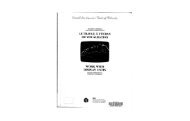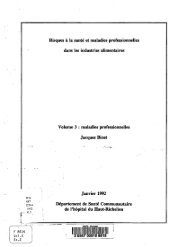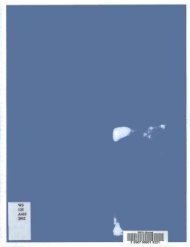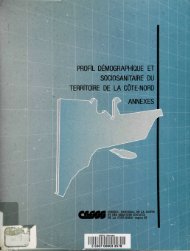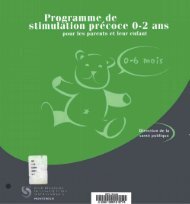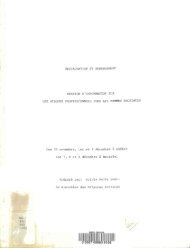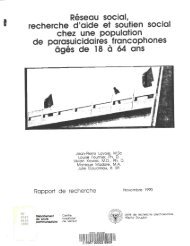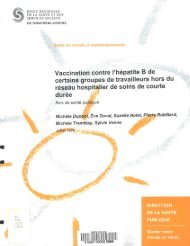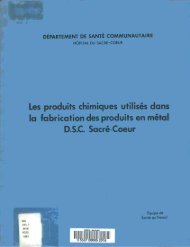COMPTE-RENDU DU COLLOQUE
COMPTE-RENDU DU COLLOQUE
COMPTE-RENDU DU COLLOQUE
Create successful ePaper yourself
Turn your PDF publications into a flip-book with our unique Google optimized e-Paper software.
Arsenic<br />
Bin am<br />
Cadmium<br />
Chromium<br />
Fluoride<br />
Lead<br />
Substance<br />
RESEARCH RISK ASSESSMENT RISK MANAGEMENT<br />
Laboratory and field<br />
obtervationi of advene<br />
health effects and ex*<br />
poiurei to particular<br />
agents<br />
Information on<br />
extrapolation methods<br />
for high to low dose<br />
and animal to human<br />
Field measurements,<br />
estimated exposures,<br />
characterisation of<br />
populations<br />
Hazard Identification<br />
(Ooes the agent cause<br />
the adverse effect?)<br />
Dose-Response Assessment<br />
(What is the relationship<br />
between dose and inei*<br />
dence in humans?)<br />
Exposure Assessment<br />
(What exposures are<br />
currently experienced<br />
or anticipated under<br />
different conditions?)<br />
Risk Characterization<br />
(What is the estimated<br />
ineidenee of the ad*<br />
verse effect in a<br />
given population?)<br />
FIGURE 1-1 Elements of risk assessment and risk management.<br />
FIGURE 15<br />
TABLE 2<br />
CANADIAN AND U. S. DRINKING WATER STANDARDS: A COMPARISON OP RATIONALES<br />
Canadian<br />
MAC<br />
(mg/1) Canadian rationale<br />
0.05 Human exposure at 0.05 tag/! has not been<br />
associated with adverse effects in limited<br />
epidemiological studies; no attempt has been<br />
made to extrapolate cancer risk from Taiwan<br />
studies<br />
1.0 Hie 2.0 mg daily exposure on water would<br />
contribute about two-thirds of the daily<br />
amount from food; lifetime studies with rats<br />
at 5 mg/1 showed no adverse health effects<br />
0.005 - Drinking water would contribute only 15% of<br />
an estimate FAO/WHC tolerance intake (or<br />
57.71 *ig/day)<br />
0.25 1*25 rag/L for 3 yean caused no in effects in a<br />
family of 4; toxic effects were seen in rats and<br />
rabbits with >5 mg/1 of hexavalent chromium<br />
1.5 Qaim that denial fluorosis may be objectionable<br />
at concentrations greater than M mg/1<br />
0.05 State that at dietary intakes of lead common in<br />
Canada, the Wood lead levels are not likely to<br />
exceed 40 Ml/100 ml, a level associated with<br />
dinical toxicity symptoms in children, when<br />
the drinking water concentration of lead<br />
remains below 0.10 mg/1<br />
FIGURE 16<br />
Development of<br />
regulatory options<br />
Evaluation of public<br />
health; economic,<br />
social, political<br />
consequences of<br />
regulatory options<br />
Agency decisions<br />
and actions<br />
Comparison<br />
vnih U S. U. S. rationale<br />
Different from U. S.<br />
Different from U. S.<br />
Different from U. S.<br />
Comparable to U. S.<br />
Comparable to (J. S.<br />
Different from U. S.<br />
/132<br />
Since arsenic was thought to be a human<br />
carcinogen. EPA wanted to limit the total<br />
exposure to arsenic Consequently, the current<br />
standard was designed to allow no more than<br />
10% of one's total daily exposure to come<br />
from drinking water.<br />
No specific human studies; based on an<br />
industrial air standard<br />
It would take 352 of Cd per day for 50 yean<br />
to reach a critical level in the kidney (200<br />
ppm) based on animal studies; at the current<br />
standard of 0.01 mg/L 20 Mg/day would be<br />
additionally contributed to an average of 75<br />
jig/day from food; thus, a safety factor of 4 is<br />
assumed<br />
Since Pb from other sources was not closely<br />
regulated and since the total daily intake of<br />
Pb that results in progressive retention is leas<br />
than twice the average intake, the standard<br />
was adopted. At the EPA standard, 25-33%<br />
of a I-3-year-old child's daily lead exposure<br />
would be derived from the drinking water



